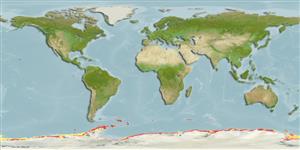>
Perciformes/Notothenioidei (Icefishes) >
Nototheniidae (Cod icefishes) > Trematominae
Etymology: Trematomus: Greek, trematos = hole + Greek, tomo = section, cut (Ref. 45335); hansoni: Species name hansoni honors Nicolai Hanson, biologist of the Southern Cross Expedition.
Eponymy: Nicolai Hanson (1870–1899) was a Norwegian zoologist and Antarctic explorer. [...] (Ref. 128868), visit book page.
More on author: Boulenger.
Issue
The genus Pseudotrematomus is a synonym of Trematomus, which is confirmed by a molecular study to be published (J.-C. Hureau, pers. comm. 08 Jun. 2010).
Environment: milieu / climate zone / depth range / distribution range
Ecologia
marino demersale; distribuzione batimetrica 6 - 549 m (Ref. 11892). Polar; 53°S - 78°S
Southern Ocean: South Orkneys, South Georgia and South Shetland islands. Ross, Davis and Weddell seas, South Victoria, Adelie, Queen Mary and Princess Ragnhild Coasts.
Size / Peso / Age
Maturity: Lm ? range ? - ? cm
Max length : 45.5 cm TL maschio/sesso non determinato; (Ref. 58849); common length : 25.0 cm TL maschio/sesso non determinato; (Ref. 2121)
Spine dorsali (totale) : 5 - 8; Raggi dorsali molli (totale) : 36 - 41; Raggi anali molli: 33 - 37. Body brownish, large dark spots or cross bars on body. Head often spotted, fins barred with series of dark spots (Ref. 11892).
Adults feed on small fishes, krill and other euphausiids, polychaetes, copepods, amphipods, isopods and small gastropods. Mature individuals spawn once a year (Ref. 1071).
Dewitt, H.H., P.C. Heemstra and O. Gon, 1990. Nototheniidae. p. 279-331. In O. Gon and P.C. Heemstra (eds.) Fishes of the Southern Ocean. J.L.B. Smith Institute of Ichthyology, Grahamstown, South Africa. (Ref. 5179)
IUCN Red List Status (Ref. 130435: Version 2024-1)
Threat to humans
Harmless
Human uses
Pesca: commerciale
Strumenti
Special reports
Download XML
Fonti Internet
Estimates based on models
Preferred temperature (Ref.
123201): -1.8 - 0.5, mean -1.1 °C (based on 348 cells).
Phylogenetic diversity index (Ref.
82804): PD
50 = 0.5005 [Uniqueness, from 0.5 = low to 2.0 = high].
Bayesian length-weight: a=0.00427 (0.00274 - 0.00663), b=3.29 (3.15 - 3.43), in cm total length, based on LWR estimates for this species & Genus-body shape (Ref.
93245).
Trophic level (Ref.
69278): 3.4 ±0.54 se; based on food items.
Resilienza (Ref.
120179): Medio, tempo minimo di raddoppiamento della popolazione 1.4 - 4.4 anni (K=0.22-0.23; Fec = 5,851-12,000).
Fishing Vulnerability (Ref.
59153): High vulnerability (55 of 100).
Climate Vulnerability (Ref.
125649): High vulnerability (57 of 100).
Nutrients (Ref.
124155): Calcium = 22.8 [13.3, 57.4] mg/100g; Iron = 0.459 [0.186, 0.931] mg/100g; Protein = 17.1 [16.1, 18.2] %; Omega3 = 0.352 [0.194, 0.626] g/100g; Selenium = 15.5 [6.3, 37.8] μg/100g; VitaminA = 23 [5, 116] μg/100g; Zinc = 0.487 [0.313, 0.759] mg/100g (wet weight); based on
nutrient studies.
